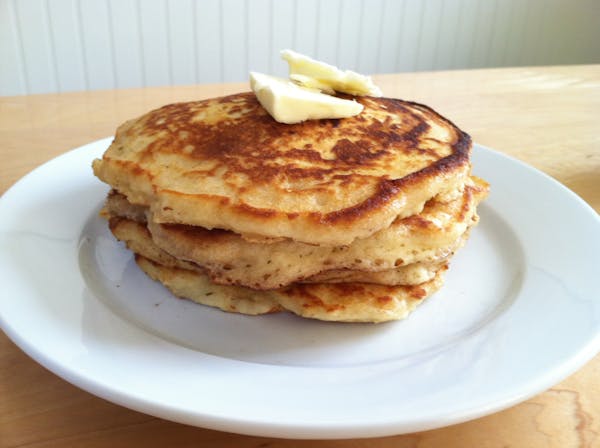Give it a rest. After mixing batter, loosely cover and let it sit on the counter for about five minutes before cooking.
Keep it hot. A well-made pancake requires a hot but not scorching pan. Here's a reliable test: Drop roughly 1 tablespoon batter into the pan. After a minute, if the cooked side is pale and beige, the pan isn't hot enough, and if it's golden brown, the temperature is correct. For electric griddle users, set the temperature in the 350- to 375-degree range.
Flipping out. It's time to turn pancakes when the face-up surface is a sea of small, un-popped bubbles.
Key ingredient. Buttermilk is the path to pancake enlightenment. It's not exactly a staple in most American refrigerators, so substitute by using this ratio: add 1 tablespoon freshly squeezed lemon juice for every 2 cups milk.
Worth the fuss. For a truly tender pancake, separate eggs (adding yolks according to instructions), whip whites into stiff peaks and, using a rubber spatula, carefully fold whites into the batter just before cooking.
Fresh and frozen. Rather than folding blueberries into the batter, sprinkle them over pancakes as they begin to set on the griddle. Use fresh berries when they're in season, and frozen during the rest of the year. For frozen berries: Thaw, place in a mesh strainer, rinse under cool water until water runs clear, then transfer berries to a paper towel-lined plate to dry. Accentuate the berry's flavor by gently tossing ½ teaspoon freshly grated lemon zest into each cup of blueberries.
Serve immediately. Pancakes are best enjoyed straight off the stove. If making a large batch, store in a 200-degree oven. For single layers, use a wire rack on top of a baking sheet, and for multiple layers, place between folds of a kitchen towel set on a baking sheet.
Finishing touch. Toppings, including butter and maple syrup, are best served at room temperature.
RICK NELSON
Make any night date night with this riff on steak frites

Review: Zendaya holds the key to tricky relationship drama 'Challengers'
New federal rule bars transgender school bathroom bans, but it likely isn't the final word

